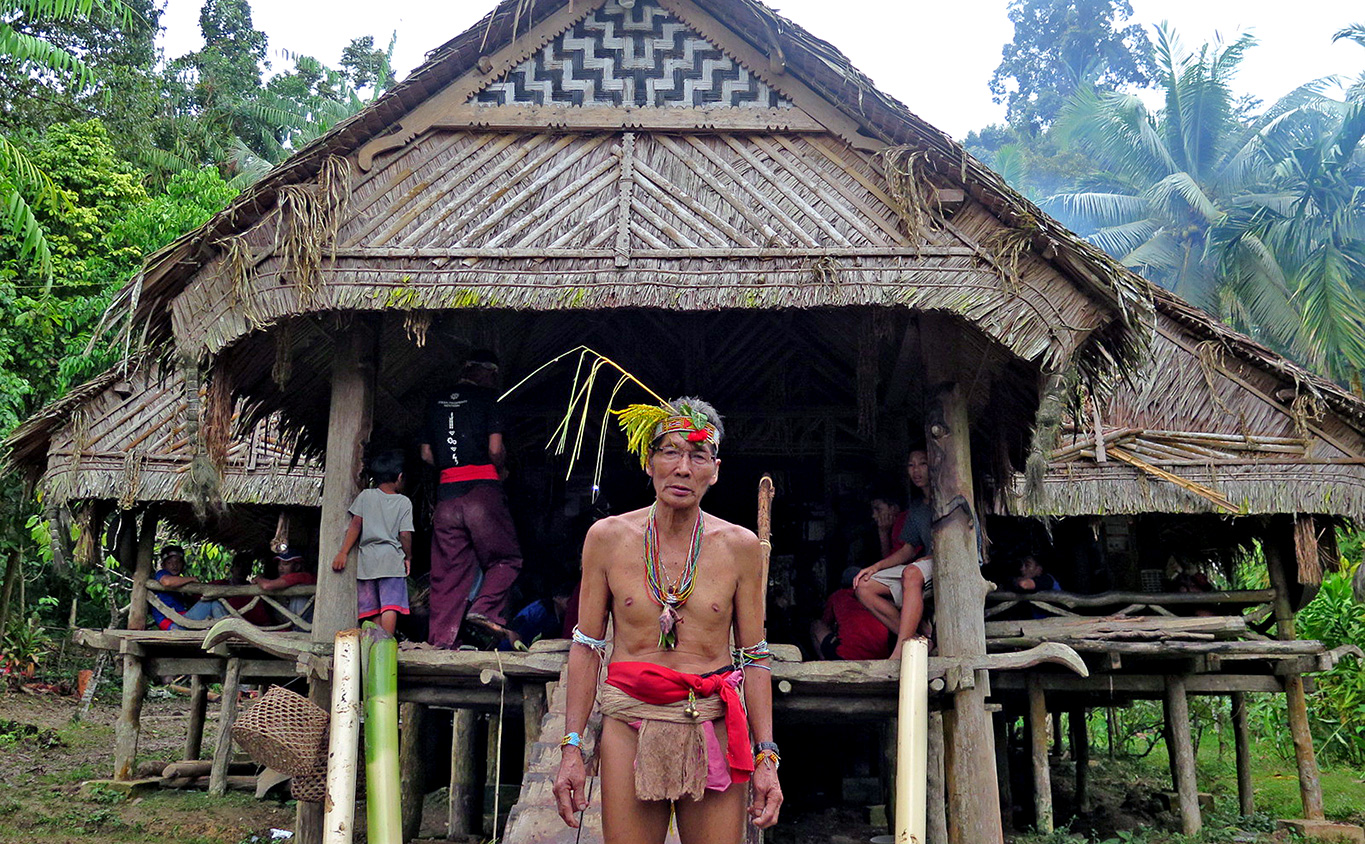The indigenous forest people of the remote Mentawai Islands, about 150 kilometers off the west coast of Sumatra in the Indian Ocean, are being pushed even further to the edge. They are powerless to defend their pristine forest, which a company has eyed for converting into a plantation. The Jakarta Post journalist Moses Ompusunggu recently visited Siberut, the largest of the three islands that make up the regency, and observed the native people’s struggle to protect their ancestral home.
It is told that long ago, the ancestors of the Sabulukkungan tribe of Siberut Island embarked on a voyage to catch sea turtles, leaving behind their children and livestock at their uma, a traditional longhouse.
At home, while their parents were away on their long journey, the children got up to mischief, teasing and laughing at a dog with total abandon, invoking the wrath of nature. A thunderbolt struck and transformed the uma into a rocky hill.
Many people of the Sabulukkungan tribe, whose faith is a blend of animism and Catholicism, still regard the folklore today as if it were historical fact. If you ask where the hill is, they will point at a hill that stands in the central Siberut district of Saibi. The 1-hectare site in the center of the tribe’s customary forest is one of their most sacred places.
Today, the hill not only holds spiritual meaning for the Sabulukkungan people, but also symbolizes their resistance against the looming threat of a timber company that wants to turn their ancestral lands into a plantation for cultivating red calliandra as biomass fuel. The company, PT Biomas Andalan Energi, is seeking an industrial forest permit (HTI) to cultivate 20,000 ha of Siberut, an area that includes the tribe’s sacred site.
“While we are increasingly powerless against the company, we will fight to the end to defend the Bukit Uma [hill house],” Bruno Tatebburuk, 64, a senior adviser to the Sabulukkungan tribe, told The Jakarta Post.
The indigenous people claim 3,000 ha of the 400,000 ha Siberut Island as their customary lands, according to the Alliance of Indigenous Peoples of Indonesia (AMAN) and the Citra Mandiri Mentawai Foundation (YCMM), a Padang-based NGO that works to empower native Mentawai people.
“The Mentawai people owned the land and forests here even before the state came into being,” said Bruno.
Siberut is the most forested island in Mentawai regency, and the local people still follow the traditional way of life, subsisting as hunters and gatherers. In 1981, it was recognized as a UNESCO biosphere.
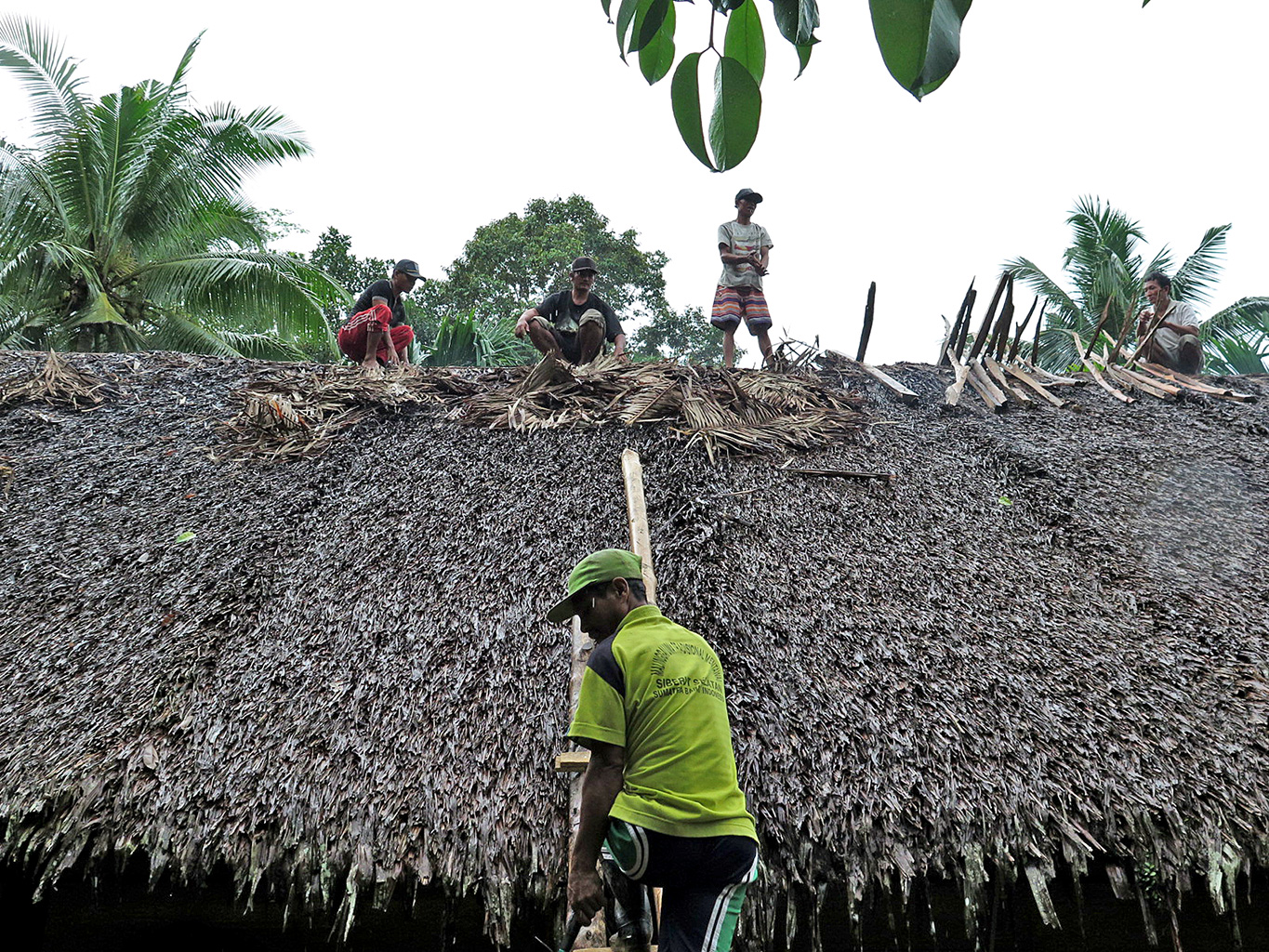 Natural materials: Tribesmen work together to repair the roof of a longhouse.
Natural materials: Tribesmen work together to repair the roof of a longhouse.
The local opposition to Biomas’s plan to acquire Siberut’s forests has received the backing of Mentawai Regent Yudas Sabaggalet. The Indonesian Democratic Party of Struggle (PDI-P) politician, who is now in his second term as regent, has argued publicly that the company’s intrusion would reduce the people’s access to their ancestral lands and thereby harm their way of life.
But in actual politics, the regent may be just as powerless as the Sabulukkungan people, because the authority to issue the permit lies with the West Sumatra provincial administration and the Environment and Forestry Ministry.
Local advocacy groups suspect that the local government helped “manipulate” the environmental impact analysis that the company needs for their project proposal to be considered.
Biomas first applied for the forest exploitation permit in 2015 only to be rejected by the government because it missed the deadline. Its claim to have secured permission from indigenous communities was greatly questioned after more than 50 tribal groups across Siberut issued a joint statement repudiating the proposed project, which would adversely affect not only their livelihood but also their unique culture.
If the company is granted the permit, it is feared that the project operations will threaten the island’s pristine forest ecosystem, particularly as the proposed area is adjacent to Siberut National Park, home to four endangered and endemic primate species.
Siberut Island, according to activists, had already fallen victim to logging operations that started in the 1970s, and suffered from perennial floods due to denuded upstream areas. Further logging would only worsen the situation.
“Life will become even more difficult for us
if the company takes our forests,”
~said Sabulukkungan tribal chief Daniel Sabulukkungan,
who lives in a traditional longhouse
and prefers to wear loincloths.
For the native people of Siberut, the forest is part of their cultural identity. More importantly, the forest is their source of nearly all daily needs, from the sago, cacao and jackfruit they harvest for their daily sustenance, to the firewood and medicinal plants they gather. They also harvest certain woods to build their houses and boats.
They ritualistically hunt the animals they use as offerings for celebrating important events like weddings and to renovate their communal longhouses. A swathe of land may be cultivated as communal property or leased to a third party at the behest of the tribal group that owns it. Under local traditions, this third party is permitted only to cultivate the land, and may neither sublease the land nor sell it. Any attempt by a company to acquire customary lands would thus inevitably lead to open conflict.
In a show of solidarity, the 52 tribal groups across Siberut that faced losing their communal property signed a joint petition to reject the company’s proposed acquisition and declared they would treat the project as a common threat.
This was not the first time that Mentawai tribes have united to defend their land. In 2014, they successfully forced the local government to shelve a plan to issue a permit for the development of an industrial oil palm plantation, which would have claimed 1,000 square kilometers of Siberut’s forests and customary lands.
“What counts the most is that we are all united when it comes to rejecting [such] business plans,” said tribal leader Jacobus Sakaliou, 54, “in spite of the problems [we have] when setting the boundaries of our customary lands.”
To avoid further complicating the issue, the Mentawai people are trying to refrain from resorting to anger when dealing with the impending threat, although they are well aware that companies and government bureaucrats break the laws and disregard local traditions.
Last year, for example, the Sabulukkungan tribal community was shocked and angered upon finding that its sacred giant durian tree had been cut down for the Trans Siberut road project, overseen by the Mentawai Public Works and Spatial Planning Agency.
Recalling the disheartening day when they lost their consecrated tree, residents claimed that the project workers chopped down the tree without notifying the residents while disregarding the tree’s cultural significance. The people’s anger subsided only after the project developer agreed to fund the longhouse’s renovation.
“I’ve been mourning for seven months. I have personally considered vengeance, but I was aware that doing so would land me in jail and my people would be placed in serious danger,” said Daniel.
The sacred tree bore the names of their dead loved ones, including Daniel’s son and older brother. On Nov. 26, Daniel and Stefanus Teusanang Sakalio, a traditional healer, visited the site to pray and to ask their ancestors to bless the souls of the departed relatives whose names were inscribed on the tree.
The sacred tree is a 90-minute walk from the Sabulukkungan longhouse in Puro hamlet, South Siberut. To reach it, The Jakarta Post traveled across the hills along dirt roads that turn muddy in the rainy season. Sago and cacao plants dominated the lush landscape.
When we arrived at the site, Daniel and Stefanus wailed while chanting a prayer in their indigenous language. They lay offerings of a bamboo tube filled with clear water, flowers and leaves.
“This [grief] is what will come if the forest is converted into an industrial estate,” said Heronimus Sabulukkungan, a villager who accompanied the two men.
Activists are trying hard to convince the Environment and Forestry Ministry, the highest government institution with the authority to issue the permit, to heed the Mentawai people’s appeal to drop the plan.
“This will be a test for [President] Jokowi to prove whether he is serious about his pledge […] to protect indigenous communities,” said Khalisah Khalid, a senior activist with the Indonesian Forum for the Environment (Walhi).
The Mentawai people’s future looks bleak, at least for now, and they need strong advocacy from civil groups to defend their rights. The local administration led the way in supporting and protecting the indigenous community late last year, when they adopted a bylaw that recognized their customary rights.
However, the higher decision-makers have yet to demonstrate their commitment to protecting and sustaining the indigenous people’s forests, source of livelihood and traditional cultures.
Indigenous people and their longhouse on Siberut
In Puro, a shady hamlet in the middle of a Siberut jungle, Nikodemus Sabulukkungan and Agustinus Durai were busy extracting the starchy insides of a sago tree their families would cook for an upcoming religious ceremony.
The two men, both 50, skillfully used a traditional scratcher, a wooden bar fitted with nails on one end. “I’ve been doing this since I was a kid,” said Agustinus as he took a break.
Their activity was part of intricate preparations for a four-day ritual for the renovation of Subulukkungan tribe’s uma, a tribal wooden longhouse central to their culture. The tribe’s tradition requires religious rituals to mark milestones in their life, like marriage, birth, death, house repair and even meetings between elders.
An uma is a traditional vernacular house built on piles with a veranda at both ends, and it has no window. Its roof is made of sago leaves, and a typical longhouse can be as large as 300 square meters and may house up to 300 people. It functions as the tribe’s cultural, social and political center.
Tucked in lush forests about a 20-minute drive from the South Siberut quay that connects the island with the outside world, the communal house needed renovations, and a ritual for divine blessing would be held before the major work began.
The majority of the Siberut population embraces Catholicism, one of the six state-recognized religions, but they still practice their ancient animistic faith. In Siberut, uma is regarded as a sacred place, a center of life even when people elsewhere on the island have embraced the “modern” lifestyle where youngsters whiz past on their motorbikes and banter on their mobile phones.
“This is a very sacred place we would cherish and defend,” tribal chief Daniel Sabulukkungan, 70, told The Jakarta Post.
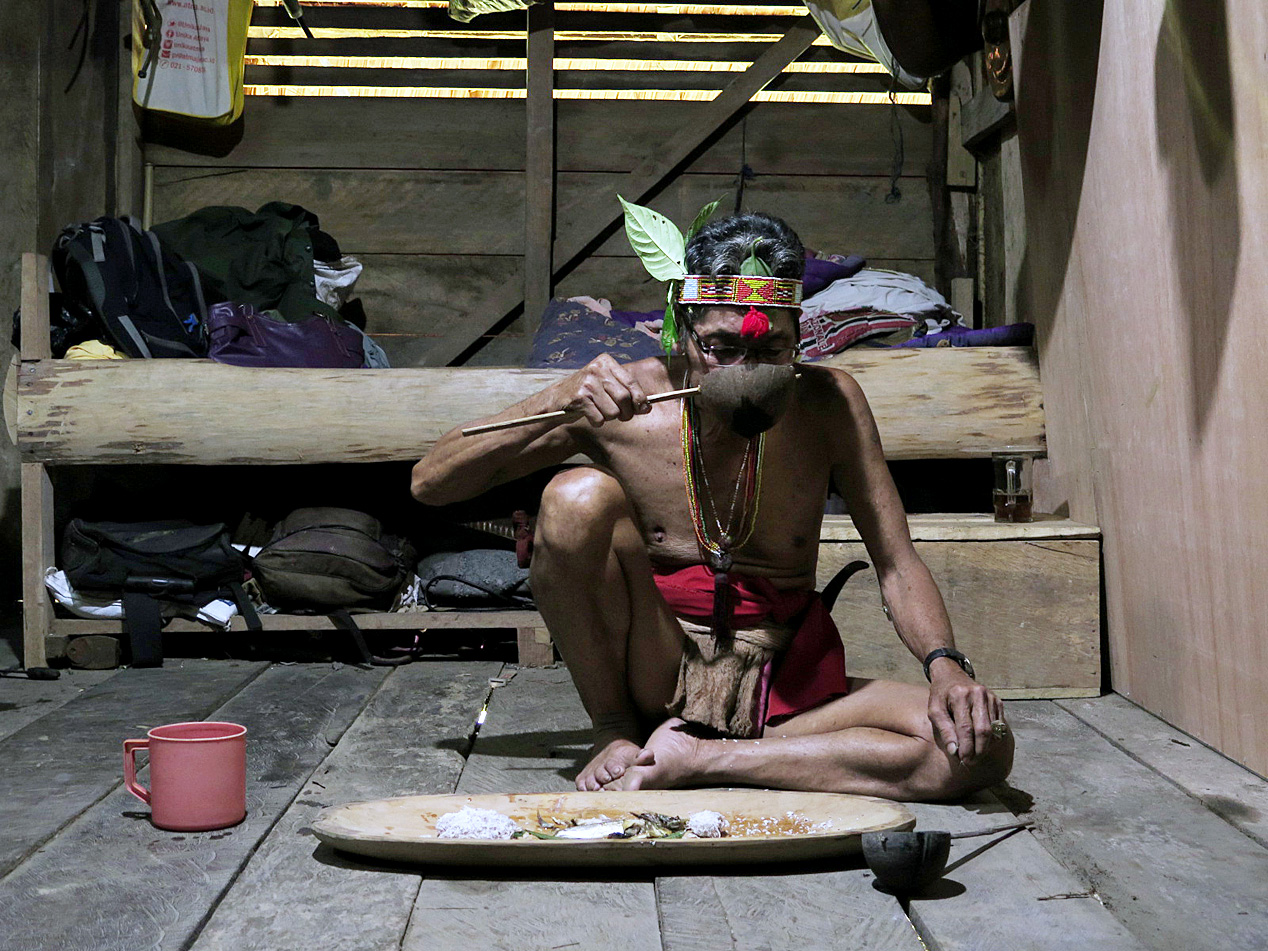 Keeping faith: A traditional healer observes a ritual ceremony. While most native people formally declare adherence to Catholicism, they also practice their ancestral animistic belief system.
Keeping faith: A traditional healer observes a ritual ceremony. While most native people formally declare adherence to Catholicism, they also practice their ancestral animistic belief system.
Daniel, who speaks broken Indonesian, said the prerestoration ritual was needed to nullify negativity that may come with the new components people had sourced from nature. They believe every part of the structure has its own soul.
“When part of the house needs mending, a ritual is obligatory to ensure our health and keep bad luck away,” said Daniel, who wears a traditional Mentawai loincloth and lives in the uma.
More importantly, the longhouse also highlights Siberut natives’ dependence on their forests, which cover nearly 85 percent of the island. The house frames are made of mangrove and the flooring is made of sugar palm wood.
“We’re inseparable from our forests,”
~said Vincentius Sabulukkungan
a fellow Puro resident.
In the preparations for the ritual, there is a clear division of labor between men and women. The men collect sago from the forest, and the women cook them as two dishes: sagu kapurut, loosely translated as sago wrapped in bamboo leaves, and sagu kaogbuk, or sago in bamboo tubes.
While most people elsewhere in Indonesia have rice as their staple food, sago is the daily sustenance for most indigenous people in Siberut, the biggest among the Mentawai islands where many people still live as hunters and gatherers.
“Rice doesn’t taste very good. Fish is best eaten with sago,” said Vincentius.
While the men installed the sago leaf roofing, the women prepared the lunch in the uma kitchen for everyone who would participate in the ceremony, including sikerei (shamans) from other villages invited to the event.
But Daniel, as the protector of the tribe, was fasting that Sunday. He would break the fast only after the renovations were completed in the afternoon, but he would have to resume fasting until the next day.
“I can neither eat nor drink. I have to fast in order to ensure the ritual runs smoothly and all members of tribe are safe and sound,” said Daniel, who converted to Catholicism in the 1960s. Like other indigenous people, he still practices animism.
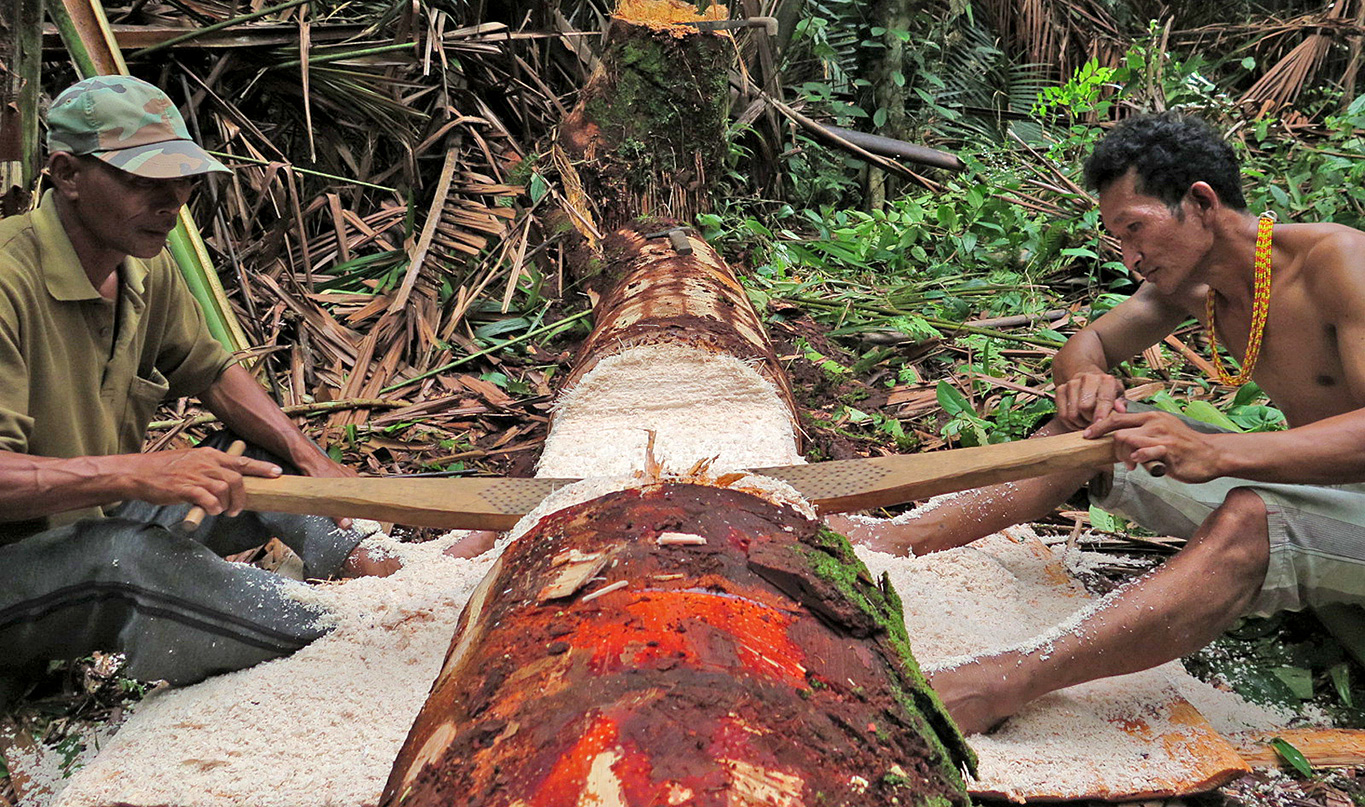 Land of plenty: Mentawai tribesmen harvest sago, a staple food, from their customary forest. Traditional communities on Siberut Island are fighting to save their forest from a proposed project that would convert much of their ancestral lands into an agricultural estate.
Land of plenty: Mentawai tribesmen harvest sago, a staple food, from their customary forest. Traditional communities on Siberut Island are fighting to save their forest from a proposed project that would convert much of their ancestral lands into an agricultural estate.
Sikerei share the responsibility of keeping evil spirits away from the house. At night, they performed an exorcism in the ceremony attended by hundreds of denizens who thronged to the uma.
One of the forest healers, Pangarita Sabaggalet, said he could sense the presence of a malevolent spirit in some wooden parts of the house, especially those sourced from the forests.
“It is the most noxious of all evil spirits. If we don’t get it out of this place, it will do harm to all of us,” said Pangarita. The evil spirit was named Sipittok.
Before performing the exorcism, the tattooed sikerei in loincloths gathered at the pedestal at the longhouse’s backyard where offerings were placed. There, they danced and chanted mantras.
Pangarita said Sippitok was extremely strong, so he and other sikerei formed a strong circle so as not to be defeated. But apparently, the evil spirit was so strong that it was capable of throwing some of the forest healers several meters, and they came crashing down near the kitchen. Pangarita appeared to be possessed by the spirit and did not recover until he was helped by Aman Keineng Kunen Saruruk, the most experienced sikerei that night.
After all of the possessed sorcerers recovered, the group of healers could finally defeat Sipittok by way of chanting mantras.
“I couldn’t control my body. I was totally frozen,” said Stefanus Teusanang Sakalio, one of the defeated sikerei, after the ceremony.
On the next day, Monday, hundreds of locals gathered again at the uma to have a dinner of pork, chicken and sago. Pigs and chickens had been slaughtered from morning to afternoon, while Daniel and the band of forest healers stayed there to pray for the dinner.
On Tuesday morning, Daniel, Stefanus and several Sabulukkungan tribe members went hunting in the forest as the final stage of the uma renovation ritual. They did not catch any animals, but it did not make the part of the ritual lose its meaning, said Stefanus, who slang a bow and bunch of arrows over his shoulders.
The ritual ended on Wednesday with Daniel and his family temporarily leaving their village for the forest. After that, Daniel returned to the uma, placing offerings at the pedestal, and marking the end of the joyous, solemnly observed ritual.
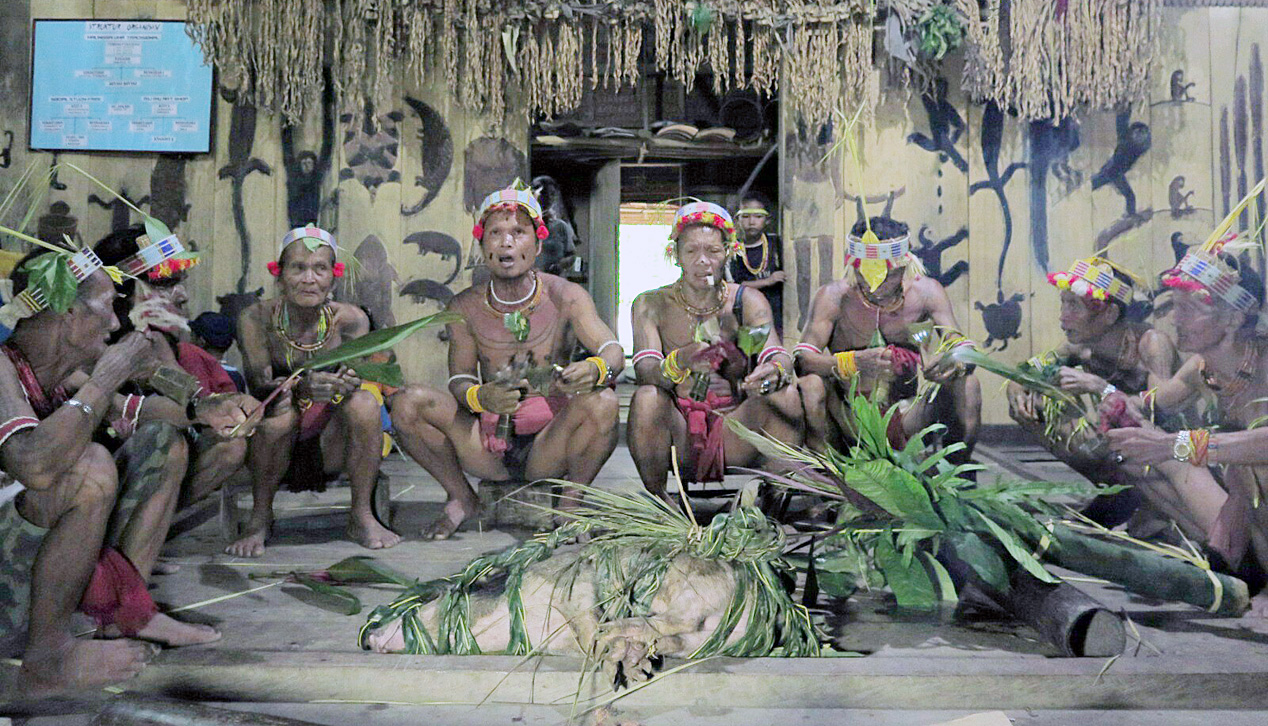 Spiritual home: Traditional healers chant a ritualistic incantation to bless the renovation of a communal longhouse.
Spiritual home: Traditional healers chant a ritualistic incantation to bless the renovation of a communal longhouse.
| Reporter | : | Moses Ompusunggu |
| Photographers | : | Moses Ompusunggu |
| Managing Editors | : | Primastuti Handayani |
| Desk Editors | : | Pandaya, Imanuddin Razak |
| Art & Graphic Design Head | : | Budhi Button |
| Technology | : | Mustopa, Sandy Riady Hasan |
| Multimedia | : | Bayu Widhiatmoko |


